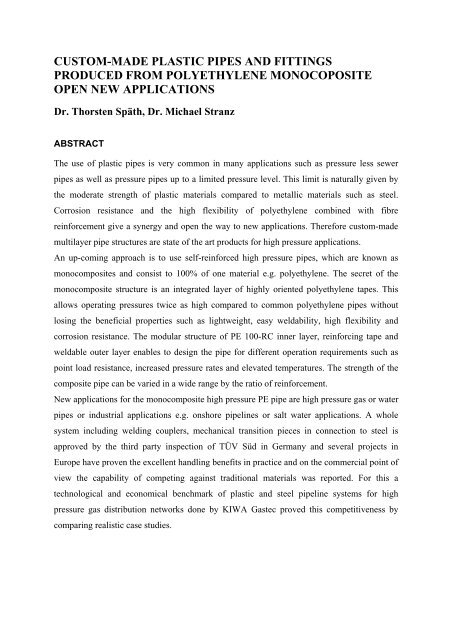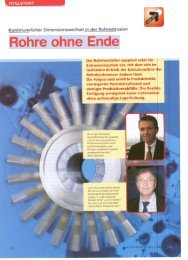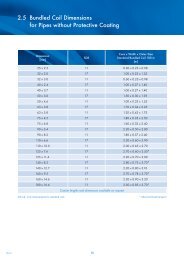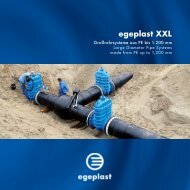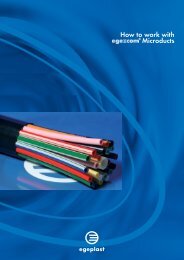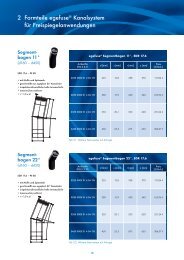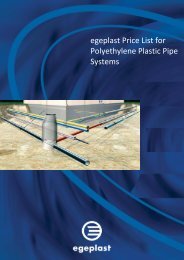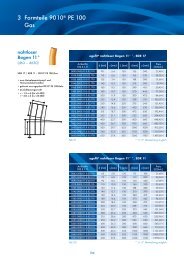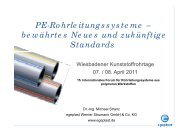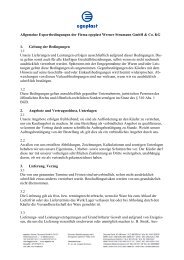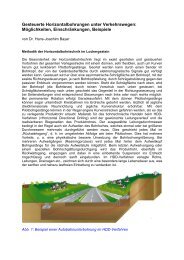custom-made plastic pipes and fittings produced from ... - Egeplast
custom-made plastic pipes and fittings produced from ... - Egeplast
custom-made plastic pipes and fittings produced from ... - Egeplast
Create successful ePaper yourself
Turn your PDF publications into a flip-book with our unique Google optimized e-Paper software.
CUSTOM-MADE PLASTIC PIPES AND FITTINGS<br />
PRODUCED FROM POLYETHYLENE MONOCOPOSITE<br />
OPEN NEW APPLICATIONS<br />
Dr. Thorsten Späth, Dr. Michael Stranz<br />
ABSTRACT<br />
The use of <strong>plastic</strong> <strong>pipes</strong> is very common in many applications such as pressure less sewer<br />
<strong>pipes</strong> as well as pressure <strong>pipes</strong> up to a limited pressure level. This limit is naturally given by<br />
the moderate strength of <strong>plastic</strong> materials compared to metallic materials such as steel.<br />
Corrosion resistance <strong>and</strong> the high flexibility of polyethylene combined with fibre<br />
reinforcement give a synergy <strong>and</strong> open the way to new applications. Therefore <strong>custom</strong>-<strong>made</strong><br />
multilayer pipe structures are state of the art products for high pressure applications.<br />
An up-coming approach is to use self-reinforced high pressure <strong>pipes</strong>, which are known as<br />
monocomposites <strong>and</strong> consist to 100% of one material e.g. polyethylene. The secret of the<br />
monocomposite structure is an integrated layer of highly oriented polyethylene tapes. This<br />
allows operating pressures twice as high compared to common polyethylene <strong>pipes</strong> without<br />
losing the beneficial properties such as lightweight, easy weldability, high flexibility <strong>and</strong><br />
corrosion resistance. The modular structure of PE 100-RC inner layer, reinforcing tape <strong>and</strong><br />
weldable outer layer enables to design the pipe for different operation requirements such as<br />
point load resistance, increased pressure rates <strong>and</strong> elevated temperatures. The strength of the<br />
composite pipe can be varied in a wide range by the ratio of reinforcement.<br />
New applications for the monocomposite high pressure PE pipe are high pressure gas or water<br />
<strong>pipes</strong> or industrial applications e.g. onshore pipelines or salt water applications. A whole<br />
system including welding couplers, mechanical transition pieces in connection to steel is<br />
approved by the third party inspection of TÜV Süd in Germany <strong>and</strong> several projects in<br />
Europe have proven the excellent h<strong>and</strong>ling benefits in practice <strong>and</strong> on the commercial point of<br />
view the capability of competing against traditional materials was reported. For this a<br />
technological <strong>and</strong> economical benchmark of <strong>plastic</strong> <strong>and</strong> steel pipeline systems for high<br />
pressure gas distribution networks done by KIWA Gastec proved this competitiveness by<br />
comparing realistic case studies.
Requirements on <strong>plastic</strong> <strong>pipes</strong> for high pressure application<br />
Polyethylene <strong>pipes</strong> have been in service for over 50 years now. They are easy to h<strong>and</strong>le<br />
because of their low weight <strong>and</strong> being very flexible they can be formed into coils which are<br />
highly convenient during installation work. The high ductility, resistance to corrosion <strong>and</strong> the<br />
easy <strong>and</strong> safe weldability allow long service lives of over 100 years [1, 2].<br />
In order to aware polyethylene pipe systems for high pressure applications <strong>and</strong> markets some<br />
basic requirements need to be fulfilled:<br />
� resistance to constant operating pressure for a reasonable time span e. g. 10, 25, 50 or<br />
even 100 years,<br />
� in case of compressible fluids, a good resistance to Rapid Crack Propagation,<br />
� <strong>fittings</strong> <strong>and</strong> connectors suitable for the required operating pressure rates to sustain all<br />
axial, hoop <strong>and</strong> bending stresses,<br />
� economic worthwhile with regard to materials, installation, <strong>and</strong> maintenance costs,<br />
� suitable for modern installation e.g. no-dig techniques.<br />
General properties of self-reinforced PE <strong>pipes</strong> due to the monocomposite<br />
design<br />
Compared to steel, the strength of polyethylene is low. Consequently, integrating materials<br />
with a higher strength e.g. polyester, aramide, or even steel fibres to reinforce the<br />
polyethylene pipe wall seems like an obvious solution. However, the strength of polyethylene<br />
pipe grades can also be increased by stretching, i.e. by specifically optimising the<br />
microstructure during processing. If such high-strength structures are used to reinforce a<br />
component of one <strong>and</strong> the same material, this is referred to as self-reinforcement or<br />
monocomposites. One advantage of monocomposites is that the strength of a component can<br />
be increased without impairing the other properties (see fig. 1).<br />
The balanced proportion of properties has been maintained <strong>and</strong> accordingly users <strong>and</strong><br />
planners are able to produce high-pressure polyethylene lines without noticing any changes in<br />
the familiar properties of PE 100 <strong>pipes</strong>. In addition, the remaining pieces can be recycled at<br />
any time in an environmentally compatible manner.
Light weight<br />
Flexibility Strength<br />
Corrosion resistance Easy weldability<br />
Fig. 1: Properties of polyethylene compared to steel<br />
Manufacturing <strong>and</strong> structure of monocomposite <strong>pipes</strong><br />
Pipe material:<br />
Polyethylene<br />
Steal<br />
Polyethylen<br />
Monocomposite<br />
Ductility<br />
Monocomposite <strong>pipes</strong> <strong>produced</strong> by extrusion in accordance with the HexelOne ® process are<br />
generally composed of three functional layers. The materials used for each layer are the wellestablished<br />
PE 100 <strong>and</strong> PE 100-RCgrades that fulfill all the requirements of DIN EN 12201-1<br />
<strong>and</strong> 1555-1 for drinking water <strong>and</strong> gas respectively [3, 4].<br />
To reach a higher performance compared to st<strong>and</strong>ard PE100 <strong>pipes</strong> the monocomposite <strong>pipes</strong><br />
incorporate a reinforcement layer <strong>made</strong> <strong>from</strong> highly oriented tapes of polyethylene, whereas<br />
the overall wall thickness equals that of the st<strong>and</strong>ard PE100 <strong>pipes</strong>. Due to the oriented<br />
structure the strength of PE 100 tapes can be increased to breaking strength > 250 MPa. This<br />
is because the micro-structure of the tapes is precisely optimised during processing by<br />
applying a combined stretching <strong>and</strong> heat treatment, resulting in a pure physical modification<br />
of the original PE 100 material. Following this procedure tailor-<strong>made</strong> high strength<br />
morphology can be realized [5, 6]. Finally these monooriented tapes can be used for<br />
reinforcement of PE100 <strong>pipes</strong>.<br />
As previously mentioned the main advantage of this polyethylene monocomposite is that the<br />
consistent multilayer structure (integrating the reinforcement layer using stretched
polyethylene) does not impair any other positive properties, for example the good welding<br />
property, the low specific weight <strong>and</strong> the flexibility necessary to produce spoolable <strong>pipes</strong>.<br />
Fig. 2: Monocomposite pipe structure<br />
Pressure rating of monocomposite high pressure <strong>pipes</strong><br />
It is well known that the long-term pressure resistance of polyethylene (MRS = Minimum<br />
Required Strength) is the decisive dimensioning parameter according to which the required<br />
pipe measurements of a specified material such as PE 100 are determined <strong>and</strong> normatively<br />
fixed to satisfy stipulated operating conditions (pressure, temperature <strong>and</strong> time) [7, 8]. The<br />
method applied to gain the MRS value is fully described in the ISO 9080 [9] st<strong>and</strong>ard.<br />
The strength of the monocomposite <strong>pipes</strong> was proven in the same way <strong>and</strong> in addition to that<br />
a second method, the so called constant linear pressure increase method (in short LPI), was<br />
applied <strong>and</strong> compared to the results coming <strong>from</strong> the ISO 9080 procedure [10, 11].<br />
The LPI-method was publihed by Barth et al. [12], wherby the influence of different<br />
water/chemicals mixtures on the pressure resistance was studied. A detailed description of the<br />
backround of the LPI-method was recently published by Dr. Hessel [13]. When using the LPImethod<br />
the main advantage is a less scope of testing, since a significant decrease of stastical<br />
spread of the test results could be observed compared to st<strong>and</strong>ard hydrostatic pressure tests<br />
described in the ISO 9080 st<strong>and</strong>ard. Following the LPI-method a very reliable prediction of<br />
the long-term hydrostatic strength can be provided for the tested pipe construction. .The<br />
resultant long-term strength was also determined following the common methods described in
the ISO 9080 by KIWA Gastec as well as SKZ on a 110x10 pipe for comparison purpose. It<br />
was found out <strong>and</strong> evaluated by third party that the LPI is capable to predict at least a<br />
minimum hydrostatic pressures strength line <strong>and</strong> is leading to similar results as the ISO<br />
st<strong>and</strong>ard.<br />
As for example the long-term strength of the monocomposite polyethylene pipe OD 110x10<br />
mm was found to be twice as high as that of an st<strong>and</strong>ard PE100 pipe although both <strong>pipes</strong> had<br />
the same overall wall thickness <strong>and</strong> were <strong>made</strong> of the same original materials. This was<br />
evaluated by both methods. However, it was the first time reported that a PE100 SDR 11 pipe<br />
(OD 110x10mm) is able to withst<strong>and</strong> hydrostatic pressures of 40 bars (20°C, water) for more<br />
than 50 Years.<br />
Resistance to Rapid Crack Propagation<br />
Although rapid crack propagation (RCP) is not used for qualifying the lifetime of a <strong>plastic</strong><br />
pipe, it is an essential property of gas <strong>pipes</strong>. This failure mechanism, also known for steel<br />
<strong>pipes</strong>, can cause severe damage <strong>and</strong> result in highly dangerous situations. As a rule of thumb<br />
one can say that the higher the operating pressure, the higher the risk of pipe failures due to<br />
RCP. The risk of RCP caused failures are also known to be higher for a larger wall thickness.<br />
The resistance of pipe-materials against RCP can be tested using full scale tests according to<br />
ISO 13478 [14], but for thermo<strong>plastic</strong> <strong>pipes</strong> a small scale steady-state (S4) test according to<br />
ISO 13477 [15] has also been developed, in order to quantify RCP in a st<strong>and</strong>ardized way.<br />
Generally when testing RCP by the S4 test method a critical pressure (Pc) above which RCP<br />
can occur as well as a critical temperature (Tc) below that RCP has to be considered were<br />
determined. It is understood that the fact that a material exhibits RCP sets limits on the<br />
combination of wall thickness <strong>and</strong> applied pressure.<br />
For a given application this means that due to lifetime <strong>and</strong> strength, most <strong>plastic</strong> materials can<br />
withst<strong>and</strong> higher pressures when using larger wall thicknesses, but due to RCP the use of the<br />
material is restricted to a maximum value equal to Pc (Tc). If for example st<strong>and</strong>ard PE 100<br />
gas <strong>pipes</strong> are pressurized above 10 bar <strong>and</strong> an excavator would locally cause a third party<br />
damage the initiated crack could rip metres of pipe length as a result of rapid crack<br />
propagation. An example of a massive crack caused by RCP is shown in figure 3a. <strong>and</strong> figure<br />
3b shows a crack arrest as the opposite of rapid crack propagation.
a) b)<br />
Fig. 3: a) Crack Caused by Rapid Crack Propagation in a Polyethylene Tube. The<br />
Crack was initiated in the RCP Testing Laboratory at Kiwa Gas Technology [16]<br />
b) Crack arrest when testing a PE monocomposite raised pressure pipe [17]<br />
To go beyond the common S4 test conditions for PE100 the monocomposite <strong>pipes</strong> were tested to<br />
determine their critical pressure <strong>and</strong> critical temperature . Due to the limitation of 55 bar of test<br />
pressure rig used for the tests <strong>and</strong> a minimum applicable test temperature of -55°C the report<br />
ends up in its summary [17]:<br />
- the critical temperature TcS4 is lower than -55°C at a testing pressure of 24.6 bar<br />
- the critical pressure pcS4 is to be higher than 24.6 bar at testing temperature of -55°C<br />
It is remarkable that under this test conditions all test samples showed crack arrest, in other<br />
words no rapid crack propagation could be observed.<br />
Third party approval for high pressure pipe <strong>and</strong> fitting system<br />
In the case of solid wall pressure <strong>pipes</strong> the long-term hydrostatic strength of the material e.g.<br />
PE 100 is the st<strong>and</strong>ard dimensioning characteristic which decides today’s usual operating<br />
pressures of maximum 16 bar for drinking water <strong>and</strong> 10 bar for gas <strong>pipes</strong> (at 20 °C <strong>and</strong> safety<br />
factors of 1.25 or 2 respectively) for the SDR 11 pipe series. The materials used as well as the<br />
pipe dimensions fit ISO 4437 [18], EN 1555 [8], ISO 4427 [19] <strong>and</strong> EN 12201 [7]<br />
respectively for gas <strong>and</strong> water distribution. EN 1555 specifies polyethylene (PE) piping<br />
systems in the field of the supply of gaseous fuels to be used with a maximum operating<br />
pressure up to <strong>and</strong> including 10 bar. It also specifies the test parameters for the test methods<br />
referred to in the current st<strong>and</strong>ard. It is applicable to PE <strong>pipes</strong>, <strong>fittings</strong>, valves, their joints <strong>and</strong><br />
to intended joints with components of other materials.<br />
The first monocomposite polyethylene pipe system, the HexelOne ® system, was certified for<br />
high pressure applications by TÜV SÜD. The approval of TÜV specifies a variety of different
tests that have to be passed <strong>and</strong> are originating <strong>from</strong> st<strong>and</strong>ards like DVGW VP 642 [20] <strong>and</strong><br />
DVGW VP 600 [21], whereby the testing conditions were thightend to justify the use of<br />
higher operating pressures. These test were performed by indepented testing institutes e.g.<br />
KIWA Gastec, SKZ, TGM, HESSEL Ingenieurtechnik etc.<br />
Recently the HexelOne ® pipeline system has already been certified for SDR 11 <strong>pipes</strong> with<br />
outer diameters of 90, 110, 125 <strong>and</strong> 160 mm.<br />
Economical Benchmarking<br />
The higher material prices of some advanced <strong>plastic</strong> pipeline systems compared to steel<br />
systems can be compensated by cost-effective installation methods. Therefore, in certain cases<br />
advanced <strong>plastic</strong> pipeline systems are really competitive to steel pipeline systems. This<br />
follows <strong>from</strong> a benchmark based on a real case study comparing different <strong>plastic</strong> pipe systems<br />
to steel pipe systems as well as different installation techniques in an economical<br />
benchmarking. The benchmarking was done by KIWA Gastec on behalf of GERK (The<br />
European Gas Research Group).<br />
It was shown that monocomposite PE <strong>pipes</strong> <strong>and</strong> solid wall polyamide <strong>pipes</strong> are competitive to<br />
steel pipeline systems both in the case of installation by digging <strong>and</strong> installation by ploughing.<br />
The cost effectiveness of the different pipe systems is compared by calculating the capital<br />
(installation, damage <strong>and</strong> repair, testing <strong>and</strong> commissioning, project <strong>and</strong> material) <strong>and</strong><br />
operational expenditure (maintenance <strong>and</strong> inspection).<br />
The materials costs of the <strong>plastic</strong> pipeline systems have been provided by the resin <strong>and</strong><br />
pipeline manufacturers. The costs of <strong>plastic</strong> pipeline fitting materials have been provided by<br />
Friatec Germany. The materials costs of steel pipelines have been provided by E.ON Ruhrgas<br />
(Germany) <strong>and</strong> Gas Natural (Spain). E.ON Ruhrgas <strong>and</strong> Gas Natural have also provided the<br />
costs of installation, damage repair, testing & commissioning, project <strong>and</strong> maintenance. The<br />
costs of installation, damage repair, testing & commissioning, project <strong>and</strong> maintenance for<br />
<strong>plastic</strong> pipeline systems are based on German prices provided by E.ON Ruhrgas.<br />
The higher material prices of some advanced <strong>plastic</strong> pipeline systems compared to steel<br />
systems can be compensated by cost-effective installation. This was clearly revealed <strong>from</strong> the<br />
economic analysis of typical reference projects (See fig. 4). The case was worked out for the<br />
outer pipe diameters of Ø160 <strong>and</strong> Ø110 mm.
Fig. 4: Total expenditure of the reference case installed by digging <strong>and</strong> ploughing when possible<br />
(Ø110 mm). Steel pipelines are installed by digging only, since steel pipeline systems cannot<br />
be installed by ploughing.<br />
Projects<br />
Due to significant cost savings several projects with monocomposite <strong>pipes</strong> were installed.<br />
The presentation will demonstrate some examples:<br />
Fig. 5a: E.ON Thüringer Energie AG<br />
4.5 km, HexelOne ® Gas pipe OD 110 mm,<br />
MOP 16 bar<br />
Fig. 5b: Stadtwerke Bad Langensalza<br />
13 km, HexelOne ® Gas pipe OD 110 mm,<br />
MOP 16 bar
Perspective<br />
Advanced <strong>plastic</strong> pipe systems like the presented monocomposite pipe system proved to<br />
fulfill the technical as well as the economical requirements for high pressure pipelines. With<br />
the currently known results, <strong>plastic</strong> pipe systems technically show good future perspectives.<br />
The required essential technical properties can be met or even be exceeded.<br />
In order to optimize the economic advantages some steps will be to optimize the<br />
monocomposite <strong>pipes</strong> for the alternative no-dig technologies. Therefore egeplast will develop<br />
high pressure pipe systems with protective <strong>and</strong> barrier layers, which provide the possibility of<br />
integrity check <strong>and</strong> permanent leakage monitoring <strong>and</strong> ware suitable for no-dig installation.<br />
Monocomposite reinforcement can also be used to develop electrofusion couplers <strong>and</strong> other<br />
pipe equipment.<br />
a) b)<br />
Fig. 5: a) High pressure <strong>plastic</strong> pipe with barrier <strong>and</strong> permanent leakage monitoring<br />
b) Electrofusion coupler <strong>produced</strong> <strong>from</strong> monocomposite reinforced sleeve<br />
List of references<br />
[1] U. Schulte: Kunststoffe (Plastics) 87 (1997) pages 203-206<br />
[2] J. Hessel: 100 Jahre Nutzungsdauer von Rohren aus Polyethylen (100 years’ life time for<br />
polyethylene <strong>pipes</strong>), 3R international (46) Issue 4/2007<br />
[3] DIN EN 12201-1 (Edition 2011-11):<br />
Plastic pipeline systems for water supply, <strong>and</strong> for drainage <strong>and</strong> sewerage under pressure –<br />
polyethylene (PE) – Part 1: General<br />
[4] DIN EN 1555-1 (Edition 2010-12):<br />
Plastic pipeline systems for gas supply – polyethylene (PE) – Part 1: General<br />
[5] A. Peterlin: Drawing <strong>and</strong> extrusion of semi-crystalline polymers,<br />
Colloid & Polymer Science, Vol. 265, Heft 5/1987
[6] J. Petermann, H. Ebener: On the micromechanisms of <strong>plastic</strong> deformation in semicrystalline<br />
polymers, Journal of Macromolecular Science, Part B, Vol. 38, Heft 5 & 6/1999,<br />
[7] DIN EN 12201-2 (Edition 2011-11):<br />
Plastic pipeline systems for water supply, <strong>and</strong> for drainage <strong>and</strong> seweragre under pressure – –<br />
polyethylene (PE) – Part 2: Pipes<br />
[8] DIN EN 1555-2 (Edition 2010-12):<br />
Plastic pipeline systems for gas supply – polyethylene (PE) – Part 2: Pipes<br />
[9] DIN EN ISO 9080 (Edition 2003-10): Kunststoff-Rohrleitungs- und Schutzrohrsysteme -<br />
Bestimmung des Zeitst<strong>and</strong>-Innendruckverhaltens von thermoplastischen Rohrwerkstoffen<br />
durch Extrapolation<br />
Plastic pipeline <strong>and</strong> protective pipe systems – determination of internal pressure creep test<br />
behaviour of thermo<strong>plastic</strong> pipe materials through extrapolation<br />
[10] M. Stranz: HexelOne Hochdruckrohre im Praxiseinsatz – Nachweis der Druckfestigkeit und<br />
Anwendungsbeispiele, Tagungsb<strong>and</strong> Wiesbadener Kunststoffrohrtage 2010<br />
[11] T. Späth: High-Pressure Pipes Made <strong>from</strong> Polyethylene Only – A New Generation of Plastic<br />
Pipes, Plastic Pipes XV Vancouver<br />
[12] J. Hessel, E. Barth, B. Kempe: Die Bestimmung der chemischen Widerst<strong>and</strong>sfähigkeit von<br />
Rohren aus thermoplastischen Kunststoffen, Materials <strong>and</strong> Corrosion 48 (1997), S. 273-288<br />
[13] J. Hessel. Kosten- und zeitsparendes Verfahren zur Erzeugung von Zeitst<strong>and</strong>kurven für Rohre<br />
aus Kunststoffen, 3R international (48) Heft 11/2009<br />
[14] ISO 13478:2007: Thermo<strong>plastic</strong>s <strong>pipes</strong> for the conveyance of fluids -<br />
Determination of resistance to crack propagation -- Test method for rapid<br />
crack propagation (RCP) -- Full-scale test (FST)<br />
[15] ISO 13477:2008: Thermo<strong>plastic</strong>s <strong>pipes</strong> for the conveyance of fluids -<br />
Determination of resistance to crack propagation – Test method for rapid crack<br />
propagation (RCP) – Small scale steady-state test (S4 test)<br />
[16] KIWA Report: “Technological <strong>and</strong> Economical Benchmark of Plastic <strong>and</strong> Steel Pipeline<br />
Systems for High Pressure Gas Distribution Networks” 2010<br />
[17] TGM Report TGM – VA 24 069: RCP – S4 Test according EN ISO 13477 on samples pipe dn<br />
160 x 14,6 mm HexelOne<br />
[18] ISO 4437:2007: Buried polyethylene (PE) <strong>pipes</strong> for the supply of gaseous fuels -<br />
Metric series<br />
[19] ISO 4427:2007: Plastics piping systems -- Polyethylene (PE) <strong>pipes</strong> <strong>and</strong><br />
<strong>fittings</strong> for water supply<br />
[20] DVGW VP 642 (2004-06): Faserverstärkte PE-Rohre (RTO und zugehörige Verbinder<br />
für Gasleitungen mit Betriebsdrücken über 16 bar<br />
[21] DVGW VP 600 (2001-07): Werkstoffübergangsverbinder aus Metall für Rohre aus<br />
Polyethylen (PE 80, PE 100) sowie aus vernetztem Polyethylen (PE-Xa) für Gas- und<br />
Trinkwasserleitungen – Anforderungen und Prüfungen


